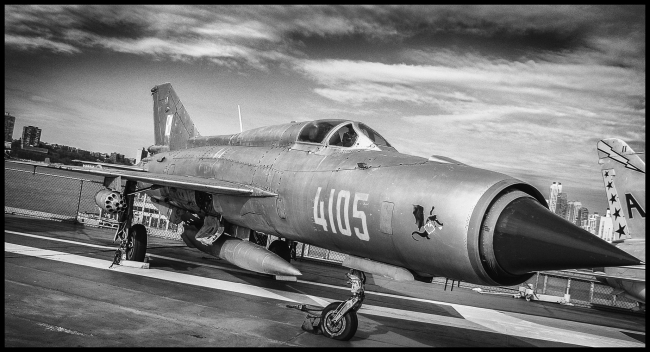According to Military Today:
The most widely produced supersonic jet fighter of all time, the MiG-21 (Western designation: Fishbed) is an incredibly prolific aircraft. Dated but nimble, it has allowed skilled pilots in past decades to defeat more advanced aircraft. However, its days appear to be numbered as the majority of air forces switch to newer fighters.
The Mikoyan design bureau began development of the MiG-21 in the 1950s, in order to replace the crash-prone MiG-19s. Its first flight was in 1956. Production began in 1959, and it entered service soon after. Although no longer in production, after over 50 years (counting Chinese production), more than 10 000 units were produced, serving in 50 countries. It holds the record for the most-produced jet aircraft. The MiG-21 continues to serve in around 20 countries to this very day.
The MiG-21 was nothing radical—it was a continuation of the existing MiGs (the 17 and the 19). Compared to its predecessor, MiG-19, the Fishbed’s main design difference is its triangular delta wings (as opposed to the swept wings on the MiG-19). Its primary improvements were its speed, better design, and greater capacity for armament. The MiG-21 was relatively simple in design and technology. This allowed to produce these aircraft in large numbers.
The MiG-21 could carry a fair amount of armament. Located to the left of the cockpit, the twin-barreled GSh-23 23 millimeter cannon was standard with 420 rounds carried. Optional were a variety of guided air-to-air missiles (the K-13, K-13M, and R-60, for later models) and unguided bombs or rockets. A total of 2 000 kilograms of ordinance could be carried.
The MiG-21 was highly maneuverable for its time, although even this feature is now outdated compared to fly-by-wire aircraft. In its day (the 60s and 70s), it posed a considerable threat in the hands of a good pilot to more modern western aircraft such as the F-4. One U.S. Air Force pilot said, “Perhaps the most important lesson on fighting the MiG-21 was that it was very maneuverable and that it was better to take care of it before you got into a tussle with it”.
In its many years of service, the MiG-21 has generated an excellent combat record, for the most part. Against Pakistani F-86s, F-104s, and MiG-19s it performed respectably, taking down several while suffering a few losses itself. Against well-trained Israeli pilots and their Mirage IIIs and F-4s, the MiG-21 and its mediocre pilots performed poorly with many shot down. In Vietnam, the MiG-21 showed its true capabilities, shooting down dozens of American F-4s or F-105s, mostly in close-range dogfights, where its maneuverability and lower speed gave it the edge. Overall, the MiG-21 has proved a highly successful fighter with a low price but much agility.
After over fifty years of service, the MiG-21 appears to still be going strong, although it is gradually leaving the scene of active service. Despite the advance of newer Russian fighters like the MiG-23 or the still more advanced MiG-29, the Fishbed has yet to be entirely ousted. Many low-budget countries continue to use it, for lack of something better. China and some other countries retain upgraded versions of this fighter aircraft.
Taken with a Konica Minolta Maxxum 5D on the USS Intrepid.

